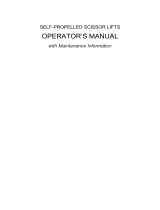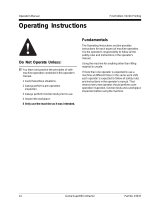
Operator's Manual Third Edition • Second Printing
18 GS-1530 • GS-1532 • GS-1930 • GS-1932 Part No. 1000032
FUNCTION TESTS
Test Drive and Braking
27 Press and hold the function enable switch.
28 Slowly move the control handle in the direction
indicated by the blue arrow on the control panel
until the machine begins to move, then return
the handle to the center position.
Result: The machine should move in the
direction that the blue arrow points on the
control panel, then come to an abrupt stop.
29 Slowly move the control handle in the direction
indicated by the yellow arrow on the control
panel until the machine begins to move, then
return the handle to the center position.
Result: The machine should move in the
direction that the yellow arrow points on the
control panel, then come to an abrupt stop.
Note: The brakes must be able to hold the machine
on any slope it is able to climb.
Test the Tilt Sensor Operation
Note: Perform this test from the ground with the
platform controller. Do not stand in the platform.
30 Fully lower the platform.
31 Place a 2x4 or similar piece of wood under both
wheels on one side and drive the machine up
onto them.
32 Raise the platform approximately 2.1 m from the
ground.
Result: The platform should stop and the tilt
alarm will sound at 600 beeps per minute.
21 Release the control handle.
Result: The platform should stop raising.
22 Press and hold the function enable switch.
Slowly move the control handle in the direction
indicated by the yellow arrow.
Result: The platform should lower. The descent
alarm should sound while the platform is
lowering.
Test the Steering
Note: When performing the steer and drive function
tests, stand in the platform facing the steer end of
the machine.
23 Press the drive function select
switch.
24 Press and hold the function
enable switch on the control
handle.
25 Depress the thumb rocker switch on top of the
control handle in the direction identified by the
blue triangle on the control panel.
Result: The steer wheels should turn in the
direction that the blue triangle points on the
control panel.
26 Depress the thumb rocker switch in the direction
identified by the yellow triangle on the control
panel.
Result: The steer wheels should turn in the
direction that the yellow triangle points on the
control panel.
























